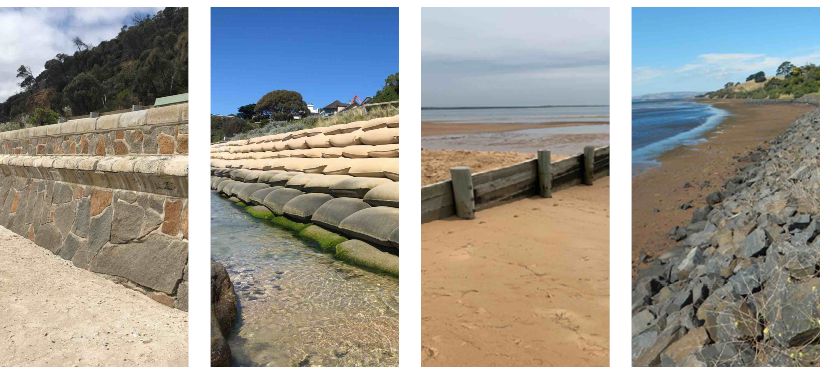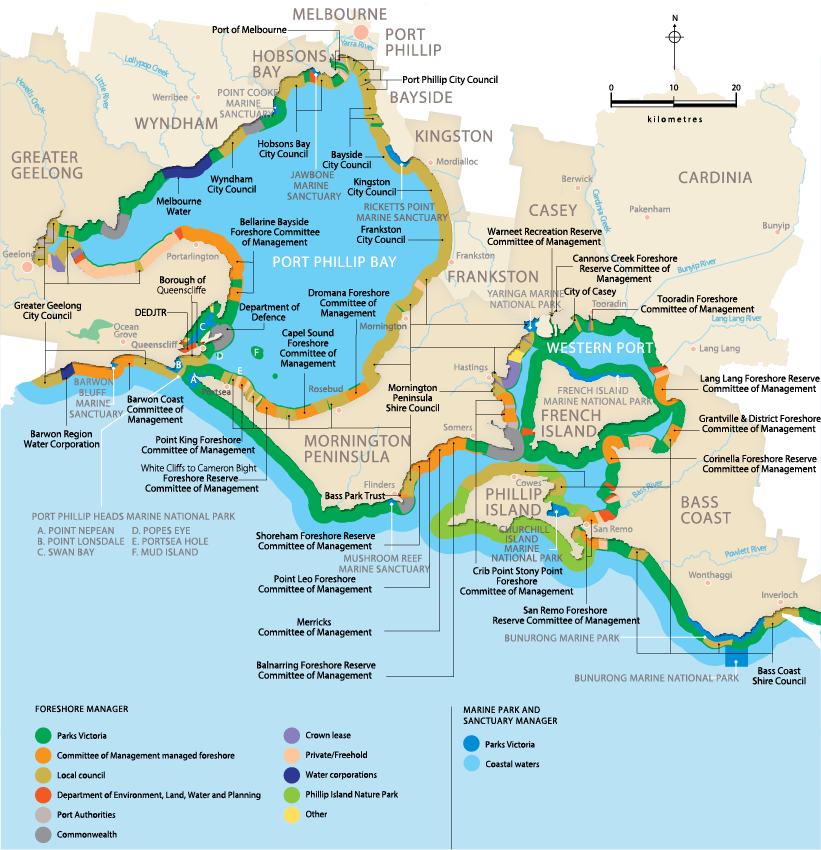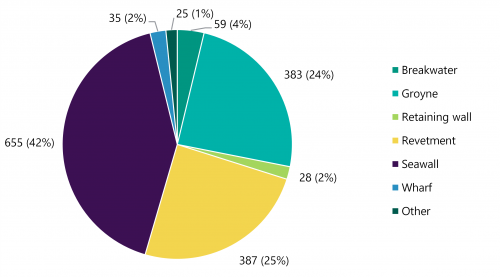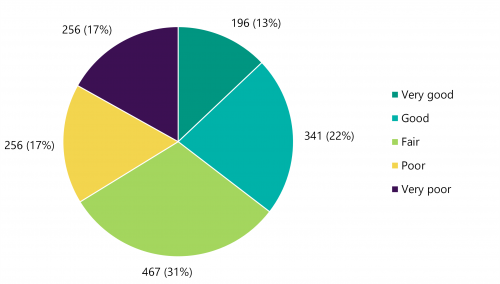Follow-up of Protecting Victoria’s Coastal Assets
Snapshot
Has the Department of Environment, Land, Water and Planning (DELWP) effectively responded to the recommendations from our 2018 Protecting Victoria’s Coastal Assets audit?
Why this review is important
DELWP has oversight of over 1,500 coastal protection assets (CPAs), valued at approximately $1.13 billion in total.
This infrastructure helps protect Victoria's coastline from hazards including inundation and erosion.
DELWP oversees 54 organisations that look after these assets as delegated coastal managers.
Our 2018 audit found weakness in DELWP's management of CPAs and oversight of coastal managers.
With climate change increasing the frequency and severity of erosion and inundation, it is timely to review DELWP's progress in addressing our 2018 audit recommendations.
Who and what we examined
We looked at DELWP's progress in implementing our 2018 Protecting Victoria's Coastal Assets audit recommendations.
What we concluded
Based on the evidence we obtained, nothing has come to our attention that DELWP has not addressed our recommendations for collection and management of CPA data and coastal hazard and risk assessment. It has also improved its asset management practices.
While DELWP has made progress, it is yet to complete addressing our recommendations relating to:
- oversight and support for coastal managers
- developing a sustainable funding model.
Video presentation
Key facts

Note: *Asset Management Accountability Framework.
Source: VAGO, based on DELWP data.
What we found
We consulted with the Department of Environment, Land, Water and Planning (DELWP) and considered its views in reaching our conclusions. DELWP's full response is in Appendix A.
Victoria's coastal protection assets
Victoria’s coastline provides significant economic, social and environmental benefits to the community.
Coastal protection assets (CPAs) help to manage a range of threats and hazards along the state's coastline. Figure A shows some of the most common CPAs—seawalls, groynes, revetments and breakwaters.
Figure A: Typical seawalls, groynes, revetments and breakwaters

Source: DELWP's Visual inspection guidelines for coastal protection structures on Crown land (2021).
Victoria's CPAs are increasingly vulnerable to coastal hazards including inundation and erosion, as climate change makes these events more frequent and intense.
Managing coastal protection assets
DELWP oversees the effective management and protection of public coastal land and its assets. It is also responsible for developing statewide policy for coastal planning and management, and guiding its implementation. It also appoints coastal managers and oversees how they perform. These include Parks Victoria, local councils and Committees of Management (CoMs).
There are 54 known entities responsible for managing and protecting Victoria’s CPAs. Along some areas of the coast, multiple coastal managers form a patchwork of relatively small areas of responsibility. Figure B shows the coastal management arrangement for the Port Phillip Bay and Western Port coastline.
Figure B: Management arrangement along Port Phillip Bay and Western Port coastline

Note: Not all land managers are shown; DEDJTR is the former Department of Economic Development, Jobs, Transport and Resources.
Source: DELWP, Central regional coastal plan 2015–2020 (2015).
Our 2018 audit
Our 2018 Protecting Victoria's Coastal Assets (our 2018 audit) concluded that the agencies responsible for Victoria's CPAs were not adequately managing them or protecting them from current and future coastal hazards.
It called for more statewide oversight of CPAs and the risks they face, and more support for coastal managers in the form of asset management skills, and climate change adaptation guidance and resourcing.
DELWP's progress in addressing our 2018 audit recommendations
Figure C outlines DELWP's own assessment and our assessment of progress in addressing the recommendations of our 2018 audit.
Figure C: Assessment of DELWP’s progress on our 2018 recommendations
| Recommended area for improvement | DELWP assessment | VAGO assessment | Details of VAGO assessment |
|---|---|---|---|
| 1. Coastal protection asset data | Complete | Complete |
|
| 2. Oversight and support for coastal managers | In progress | In progress |
|
| 3. Sustainable funding models | Complete | In progress |
|
| 4. Asset management practices | Complete | Complete |
|
| 5. Coastal hazard and risk assessment | Complete | Complete |
|
Source: VAGO, from DELWP documents.
We found nothing in the documentation we reviewed that leads us to believe that DELWP has not addressed our 2018 audit recommendations for:
- collecting and maintaining data on CPAs
- better understanding coastal hazards and risks
- asset management practices.
However, we found that DELWP needs to do further work to address our recommendations relating to:
- oversight of coastal managers
- developing a sustainable funding model.
Improved collection and management of CPA data
What DELWP has done to address our recommendation
Developing a CPA inventory
DELWP has made significant progress addressing our recommendation to improve the way it collects CPA data.
DELWP's asset portfolio includes assets on land managed by DELWP and voluntary CoMs. In 2021, DELWP conducted an inventory of the CPAs across Victoria. Figure D shows the different types of the 1,572 CPAs that DELWP surveyed as part of this project.
Figure D: Number, proportion and type of CPAs inspected (2021)

Source: Coastal protection asset condition data collection, summary report, DELWP.
Understanding CPA condition
As part of the 2021 inventory, DELWP also rated the condition of 1,516 CPAs, as shown in Figure E.
Figure E: Asset condition assessment results (2021)

Note: DELWP told us that it gave a condition grade to only 1,516 of 1,572 inspected assets because some assets were partially buried and could not be graded.
Source: Coastal protection asset condition data collection, summary report, DELWP.
DELWP collected detailed information about the assets, including their heights, lengths, primary materials and conditions. It then compiled the data in its Coastal Asset Management System (CAMS).
Inspectors collected more comprehensive condition data on CPAs in 'poor' or 'very poor' condition to better understand the work needed to fix them.
Improved oversight of coastal managers
In 2018 we found DELWP had limited oversight of coastal managers. This made it harder for DELWP to integrate its planning with coastal managers' and develop risk based approaches to managing CPAs.
To address governance and oversight issues, we recommended that DELWP:
- adequately resource its oversight role
- clarify coastal asset management roles and responsibilities, including the performance measures it will hold coastal managers accountable for.
What DELWP has done to address our recommendation
DELWP has completed its Marine and Coastal Policy 2020 (the Policy) and Marine and Coastal Strategy 2022 (the Strategy). These address our recommendation in our 2018 audit and establish strong foundations for the state's marine and coastal management.
The Policy and Strategy have clarified DELWP's and coastal managers' roles and responsibilities for managing coastal assets. They also offer some principles to support the oversight of coastal asset managers.
However, while the Policy and Strategy lay the foundations for better statewide oversight of coastal asset managers, DELWP is yet to establish monitoring and evaluation processes to oversee and support coastal managers' performance.
Areas for improvement
Progress in overseeing managers' performance
According to DELWP, the Policy and the Strategy provide mechanisms to guide integrated planning with coastal managers and allow DELWP to monitor, evaluate and report on their performance.
The Policy guides coastal managers to plan and manage marine and coastal areas in accordance with the guiding principles and objectives of the Marine and Coastal Act 2018 (the Act). It provides direction to coastal managers on how to integrate marine and coastal planning and management by using planning tools such as coastal and marine management plans (CMMPs) and other mechanisms outlined in the Act.
However, most small-to-medium-sized coastal managers do not have CMMPs because the Act does not require it. This means DELWP is yet to establish a performance monitoring and evaluation process for most coastal managers.
DELWP is also yet to identify key indicators and targets to monitor and evaluate coastal managers' performance.
Providing sufficient resources to regional staff
Good governance facilitates sound planning, effective decision-making, knowledge sharing and better prioritisation of resources along the coast.
For DELWP's oversight to be effective, it needs to actively engage and monitor a large number of coastal managers and other stakeholders across the state.
Regional staff are DELWP's key point of contact with coastal managers. DELWP can better oversee coastal managers by making sure these staff have the training and resources to engage with and support them.
Sustainable funding models
In 2018 we found that it was challenging for DELWP to meet the costs of ageing and deteriorating assets. CPAs can be expensive to maintain, replace and decommission. Coastal hazards and risks can increase these costs, such as when extreme weather damages or destroys assets.
Ineffective targeting of constrained funding was preventing effective asset protection and management.
We also found that instead of a risk-based approach that targeted limited resources to assets with the highest value and risk, agencies were reacting to assets as they failed. In our 2018 audit, we referred to this as a ‘fix-on-fail’ approach.
Our 2018 audit recommended that DELWP develop an understanding of the statewide costs of properly managing and maintaining significant CPAs. This would enable coastal managers to prioritise their constrained resources to best protect and maintain current CPAs.
What DELWP has done to address our recommendation
While funding challenges continue, DELWP has made progress in costing CPAs' values and maintenance requirements. In late 2021, DELWP estimated the total value of CPAs in Victoria at $1.13 billion. The number and asset value of CPAs for which DELWP has direct responsibility is a lower figure of 495 assets, worth $297.3 million.
DELWP has improved its understanding of costs by:
- assessing the quality and scope of its asset data, including condition assessments
- working with the Valuer-General’s Office to confirm the data requirements to value all CPAs on coastal Crown land
- contracting a consultant to estimate like-for-like replacement costs for DELWP's portfolio of assets.
DELWP developed a 'desired funding model' for the services—including CPAs—covered by its Strategic Asset Management Plan 2021–2041 (SAMP). This 20-year funding model aims to 'enable assets to meet expected useful lives through sufficient capital and maintenance funding'.
The model accounts for capital upgrade and renewal, maintenance and operational costs, which total an estimated $23.5 million per year for the entire Victorian portfolio, which DELWP oversees. This includes $6.9 million per year for the assets DELWP is directly responsible for under the Standing Directions 2018 under the Financial Management Act 1994.
Using risk data to prioritise asset funding
DELWP’s SAMP acknowledges that pre-existing asset funding models ‘[do] not incorporate risk and climate change impacts due to limited data availability’.
Given the financial challenges of maintaining many assets in poor and very poor condition, DELWP has focused on collecting data to create risk treatment plans that will guide its funding decisions.
DELWP's commissioned report, Coastal Protection Assets–Risk Assessments and Treatment Plans summary report, was completed in May 2022. Building on DELWP's 2021 CPA condition assessments and valuations data, the report presented:
- risk assessments for assets in 'poor' or 'very poor' condition
- risk treatment plans for assets rated as 'a significant risk or worse'.
DELWP's risk assessment process complied with ISO31000 risk management standards, addressing a component of our 2018 recommendations.
DELWP is currently procuring services to use this report to inform a proposed capital works and maintenance program based on various funding scenarios. It also plans to update CAMS to include fields for risk assessment data to support more efficient and transparent decision-making.
Areas for improvement
Transitioning from ‘fix-on-fail' to risk-based approaches
DELWP’s 2021 Coastal Protection Assets—Service Framework acknowledged that its current planning approach to fix assets as they fail is 'short sighted' and 'is not the best use of constrained capital budgets'.
DELWP's 2022 Risk Assessment report and SAMP express an intention to move away from reactively repairing assets when they break. But with so many CPAs in poor condition, fix-on-fail may be still occurring while a backlog of asset maintenance is being addressed. However, DELWP advised that a June 2022 funding agreement had been informed by a risk-based maintenance approach.
Sharing CPA data as part of coastal managers' practice
DELWP still needs to strengthen coastal management practices by sharing CPA data with coastal managers.
DELWP told us it will share this condition data after it completes its risk treatment planning project. This is because it wants to give coastal managers information from expert engineers about the risks at each site and a treatment plan to mitigate these risks.
Developing better CPA management practices
In our 2018 audit we assessed DELWP's CPA management practices against key elements of Victoria's Asset Management Accountability Framework (AMAF) and found significant gaps.
What DELWP has done to address our recommendation
Since our 2018 audit, DELWP has participated in 3 annual AMAF assessments. These assessments show improvements since 2018.
Moreover, DELWP developed its 2020 building capability of land managers in asset management project to:
- align coastal management practices with the AMAF
- develop risk registers to comply with ISO31000.
Compliance with the AMAF
Three annual assessments since 2019–20 found CPAs to be materially compliant with the AMAF.
The 2021 AMAF assessment found that DELWP:
- had improved its CPA management practices
- had significantly improved its asset condition data
- was undergoing a ‘maturation process’.
It gave DELWP’s CPA management practices no ‘non-compliant’ ratings, though it assessed most areas as ‘partially compliant’.
The 2022 AMAF assessment showed further improvement. It found that DELWP had:
- improved its provision of asset management
- provided updated guidance to CoMs
- implemented an approved CPA governance model.
It gave DELWP 18 compliant and 18 partial compliance findings.
Better understanding coastal hazards and risks
Our 2018 audit noted gaps in DELWP's understanding of coastal hazards and risks, including:
- inundation and erosion because of climate change
- rising sea levels
- increasingly extreme weather events.
What DELWP has done to address our recommendation
Since 2018 DELWP has made considerable progress in monitoring Victorian coasts and assessing the hazards they face. This work has improved the quality of DELWP's coastal hazard data and helped fill knowledge gaps about the future risks of climate change on CPAs.
Progress in coastal monitoring
Through its Victorian Coastal Monitoring Program (VCMP) and Wave Climate projects, DELWP has collected large-scale data and analysed sediment and coastal waters. This has improved its forecasting of sea-level rise and extreme coastal wave movement.
These outputs address our 2018 recommendations relating to the lack of recorded data about coastal hazards and the risks they pose to CPAs.
Progress in assessing coastal hazards
Prior to our 2018 audit, DELWP had completed 4 pilot coastal hazard assessments for Port Fairy, Bellarine, Western Port and Gippsland (between 2013 and 2017), producing valuable coastal hazard data.
Since 2018, DELWP has used its hazard assessment output data and data from the VCMP and Wave Climate project to update the statewide coastal hazard assessment of erosion and inundation in future climate change scenarios.
DELWP is also addressing our 2018 recommendations through several other significant projects.
For example, it is using high-resolution aerial images from the VCMP's citizen science programs to model future change in shoreline position and beach sediment volume.
DELWP is also leading the Port Phillip Bay coastal hazard assessment and modelling future climate scenarios for land around Port Phillip Bay that flooding, shoreline, and groundwater changes is likely to affect.
Guidance in responding to climate hazards
Our 2018 audit found coastal managers lacked guidance in future planning for climate change adaptation. We recommended that DELWP give coastal managers more support to respond to climate change risks.
We found that DELWP has since developed tools and online resources to support coastal manager’s decision-making and planning relating to climate change.
DELWP has also revised policies and regulation to support planning authorities and coastal managers to:
- evaluate and mitigate coastal hazard risks from projected sea-level rise
- avoid or minimise exposing current and future CPAs to these risks.
In addition, DELWP organised 4 workshops in 2019–20 that aimed to improve coastal managers' understanding and build their capacity to respond to coastal risks and climate change.
Appendix A. Submissions and comments
Click the link below to download a PDF copy of Appendix A. Submissions and comments.
Appendix B. Acronyms, abbreviations and glossary
Click the link below to download a PDF copy of Appendix B. Acronyms, abbreviations and glossary
Click here to download Appendix B. Acronyms, abbreviations and glossary
Appendix C. Scope of this review
Click the link below to download a PDF copy of Appendix C. Scope of this review.
Appendix D. Summary of DELWP's attestations on its progress in addressing our 2018 audit recommendations
Click the link below to download a PDF copy of Appendix D. Summary of DELWP's attestations on its progress in addressing our 2018 audit recommendations.

